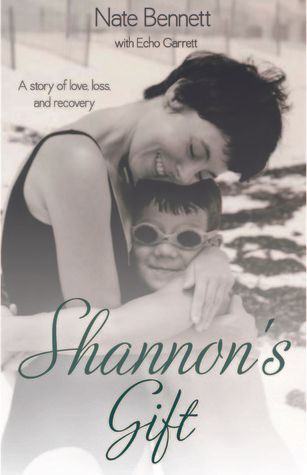

Title: Shannon’s Gift: A Story of Love, Loss, and Recovery
Author: Nate Bennett
Genre: Grieving, loss, love story
Publish Date: June 1, 2014 P
ublisher: Booklogix
Event organized by: Literati Author Services, Inc.
~ Book Synopsis ~
In this raw, emotional memoir, Nate Bennett shares the blog he maintained to work through his grief over the sudden loss of his wife Shannon. He is surprised and comforted to discover a vast virtual community of support. His blog posts—alternately poignant and of dry wit—eventually attracted tens of thousands of hits and a following from readers who hadn’t known the couple. This unique book gives the reader a window into the starkness of a widower’s grieving experience in real time. What comes through in virtually every post is his love for Shannon as he weaves in vignettes from their life together, chronicling their love story and his efforts to recover. And in the end, with the support of his virtual community and the strength he was able to draw from remembering Shannon’s wishes for him, he finds love again.
Add to Goodreads:
Purchase Links:
Excerpt:
November
10
Today
I am thinking about the best age to become a widower. The question came to mind
because I found myself thinking that from where I stood, the grass was greener
in every direction. I hate the self-pity—I really do. So I was trying to work
my way through it to get past it. If I was younger, I might not have Spencer
and Reid. Or I might be in a severe struggle to try to raise them right. Or would
have lots of mobility restrictions. But if I was younger I would feel like there
was still enough runway ahead to
use
to launch something great. If I was older, I might not feel as frightened about
spending the time I have left alone. I might be able to just work myself to
death. I like my work—so that isn’t as bad as it sounds. But 30 years of
working myself to death is too long.I think I am a widower at the worst age. I
am a ‘tweener widower. Too old for round two, too young to throw in the towel.
So much for working through the self-pity! Changing the sheets today. The
thought passed that I could wash the sheets half as often if I slept for a week
on myside and then a week on Shannon’s side. Think of all the water I would
save the planet. I could be an eco-hero. I quickly realized that I am careful
when I go to bed, when I wake up, when I walk around the bedroom, to NOT look
at Shannon’s side of the bed. I have her side of the bed covered with pillows.
I think part of me is trying to “hide” her side of the bed from the rest of me.
So I don’t think I’ll be sleeping over there any time soon. The final deep
thought for the day was that my bad moments come in two different flavors. I am
not sure I understood them this way before. One is when I am overcome by
loneliness from missing Shannon. I get very, very sad. That is a curl up in a
ball and wait for it to pass thing. The other is when I am overcome with fright
about being alone. That is a get up and do stuff to be distracted thing. So
today was a frightened about being alone day. Boy, was I busy. Bank, carwash,
tailor (she said “it’s good to see you,” not “how are you?”), Reid’s bank,
FedEx shop, lunch, grocery store, liquor store (for party Sunday). Came out to
the car, turned on the car. Song playing on the radio is “Miss You” by the
Rolling Stones. Really? Not fair.
What is Mitochondrial Disease?
Tell us about Shannon’s illness:
Shannon
suffered from mitochondrial disease – or mito as it is known to the
victims,
friends, and family of those afflicted. A mito patient’s mitochondria
are
not effective at “producing the power” that cells need to function and
that
organs need to thrive. It is relatively rare; something like 1 in 3,000
are
affected
by it. Its cause is not well understood, there is no truly effective
treatment,
and there is no cure. On the other hand, mito is critical to
understand
because the cellular function that mito patients lose is though to
play
a role is an entire constellation of conditions, including ALS, autism,
and
Parkinson’s.Shannon
was diagnosed in her early twenties, around the time that we were
married.
Her primary concern was whether or not she would pass it on to any
children.
At the time, she was advised that the greater risk was to her health
in
carrying a child to term. She was undeterred; we married and had two very
healthy
boys.During her 20s and 30s, mito was really on our radar. That approach
made
sense
because there wasn’t a treatment that was anything beyond a hope
and
a prayer – and because the best doctors could tell her was that she
either
would
either (a) experience a slow descent caused by the unavoidable and
untreatable
cumulative effects of mito or (b) die of some other natural cause
before
mito had a chance to hurt her. She did try things that were thought to
help,
such as co-enzyme Q10 and L-carnatine, but all she could tell they were
doing
was creating unpleasant side-effects. Mito was out of sight and out of
mind.
In her 40s, the signs of mito’s impact began to appear. Her vision – never
great
–
got worse. Ocular myopathy, droopy eyelids, etc. She had problems with
digestion.
She started to have problems chewing and swallowing. She hardly
ever
complained. What she was was afraid of what she saw coming – an
active
mind trapped in a body that couldn’t function. She was spared that future by
her death. After she and I dropped our youngest at College, she finally
underwent arthroscopic shoulder surgery as an outpatient. The doctor came
to tell me about the success of the procedure
and
sent me to get the car. Unfortunately, all the years that all of her
systems
were
not being properly “fed” with energy caught up to her. Though she had
awoken
fine from the procedure, recovery was too much for her and she
collapsed
while I was driving around to pick her up. She died 11 days later
and
the blog started.
About the Author
 In the fall of 2011, Nate lost his wife of 26 years in a shocking turn of events. She’d just had an outpatient procedure on her shoulder and the doctor sent Nate to get the car to bring her home. In the next few minutes, things went terribly wrong. Shannon collapsed, never to recover. After more than a week in a critical care unit in pursuit of a cure, Nate honored Shannon’s wishes and had her life support discontinued and she died shortly later. Nate’s book, Shannon’s Gift, is the result of the blog Nate kept during Shannon’s hospitalization and after her death. Initially, the purpose of the blog was to keep friends and family informed of Shannon’s condition. Quickly, though, the blog became Nate’s catharsis and a way to stay connected to a web of supporters.
After the sudden loss of his wife, Nate was surprised and comforted to discover a vast virtual community of support. His blog posts – alternately expressing poignancy and dry wit – eventually attracted tens of thousands of readers and a following from people around the world that didn’t even know Nate or his wife. The unique book gives the reader a window into the starkness of a widower’s grief in real time and a look at how social media has changed grieving in today’s world. In the end, with the support of his virtual community and the strength he was able to draw from remembering Shannon’s wishes for him, he finds love again.
While Nate is new to the personal memoir genre, he is co-author of two management books, "Riding Shotgun: The Role of the COO" and “Your Career Game: How Game Theory Can Help You Achieve Your Professional Goals.” Both are books published by Stanford University Press. Additionally, his research has been published in respected scholarly journals such as the Academy of Management Review, the Academy of Management Journal, Psychological Bulletin, and the Journal of Applied Psychology. He has also published in many widely read resources for managers including the Harvard Business Review, Wall Street Journal, BusinessWeek.com and Forbes.com.
Nate Bennett is a professor of the J. Mack Robinson College of Business at Georgia State University in the summer of 2012. From 1999 to 2012, he was on the faculty of the business school at Georgia Tech, where he most recently held the position of the Catherine W. and Edwin A. Wahlen Professor of Management. From 1999 until 2010, he served as associate dean and then as senior associate dean. Prior to Georgia Tech, he served on the faculty at Louisiana State University. While at LSU, he served at times as the management department’s Ph.D. program coordinator, department chair, MBA program director, and associate dean.
Nate holds a BA in sociology, as well as a MA in Social Research from Tulane University. He earned his Ph.D. in Management from the Georgia Institute of Technology. He resides in Atlanta, GA.
In the fall of 2011, Nate lost his wife of 26 years in a shocking turn of events. She’d just had an outpatient procedure on her shoulder and the doctor sent Nate to get the car to bring her home. In the next few minutes, things went terribly wrong. Shannon collapsed, never to recover. After more than a week in a critical care unit in pursuit of a cure, Nate honored Shannon’s wishes and had her life support discontinued and she died shortly later. Nate’s book, Shannon’s Gift, is the result of the blog Nate kept during Shannon’s hospitalization and after her death. Initially, the purpose of the blog was to keep friends and family informed of Shannon’s condition. Quickly, though, the blog became Nate’s catharsis and a way to stay connected to a web of supporters.
After the sudden loss of his wife, Nate was surprised and comforted to discover a vast virtual community of support. His blog posts – alternately expressing poignancy and dry wit – eventually attracted tens of thousands of readers and a following from people around the world that didn’t even know Nate or his wife. The unique book gives the reader a window into the starkness of a widower’s grief in real time and a look at how social media has changed grieving in today’s world. In the end, with the support of his virtual community and the strength he was able to draw from remembering Shannon’s wishes for him, he finds love again.
While Nate is new to the personal memoir genre, he is co-author of two management books, "Riding Shotgun: The Role of the COO" and “Your Career Game: How Game Theory Can Help You Achieve Your Professional Goals.” Both are books published by Stanford University Press. Additionally, his research has been published in respected scholarly journals such as the Academy of Management Review, the Academy of Management Journal, Psychological Bulletin, and the Journal of Applied Psychology. He has also published in many widely read resources for managers including the Harvard Business Review, Wall Street Journal, BusinessWeek.com and Forbes.com.
Nate Bennett is a professor of the J. Mack Robinson College of Business at Georgia State University in the summer of 2012. From 1999 to 2012, he was on the faculty of the business school at Georgia Tech, where he most recently held the position of the Catherine W. and Edwin A. Wahlen Professor of Management. From 1999 until 2010, he served as associate dean and then as senior associate dean. Prior to Georgia Tech, he served on the faculty at Louisiana State University. While at LSU, he served at times as the management department’s Ph.D. program coordinator, department chair, MBA program director, and associate dean.
Nate holds a BA in sociology, as well as a MA in Social Research from Tulane University. He earned his Ph.D. in Management from the Georgia Institute of Technology. He resides in Atlanta, GA.
Author’s Social Media

No comments:
Post a Comment